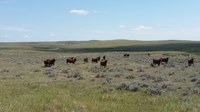Precipitation Predictor of Forage Production Potential
(Click the image below to view a high-resolution image that can be downloaded)
Below-average precipitation in much of North Dakota this spring is creating concern about impacts on forage production for the upcoming grazing season.
Some areas of western North Dakota have received less than 50% of normal precipitation to date.
“As producers prepare for the grazing season, it is important they understand the relationship between precipitation and forage production in their area,” says Kevin Sedivec, North Dakota State University Extension rangeland management specialist. “In North Dakota, April-June precipitation is a good predictor of annual forage production in mixed-grass prairies.”
While many areas in western North Dakota are lagging behind in precipitation, they still have the potential for adequate precipitation in May and June, resulting in normal forage production. However, as the growing season progresses, the potential for timely precipitation and forage growth decreases. By July 1, cool-season-dominated grasslands in North Dakota have produced 80% of their forage, whereas this is delayed to Aug. 1 for warm-season-dominated grasslands.
“Due to the relationship between precipitation and forage production, April-June precipitation can be used to predict potential deficits in forage production,” says Miranda Meehan, Extension livestock environmental stewardship specialist. “For example, if precipitation during this period is 75% of normal, producers can expect forage production to be 25% lower than normal. These predictions of production then can be used to make forage and grazing management decisions earlier in the grazing season that balance resources and reduce risk.”
Ranchers can use precipitation records for their location to predict the potential for forage production. This can be done by comparing the current year’s precipitation during this time period with the median precipitation for the last 30 years at your location. You can use this information to calculate the probability of receiving adequate precipitation for forage growth.
“We recommend using the last 30 years to account for the large amount of variation between years,” Meehan says.
For example, if your location typically receives 6.88 inches of precipitation in April and June and you received 2.5 inches in April and May, you will need to receive 4.38 inches in June to achieve normal forage production.
“You can determine the probability that you will receive adequate precipitation to achieve normal forage production levels by assessing the number of times you have received 4.38 inches in June in the last 30 years,” Sedivec says. “You have received 4.38 inches 12 times in the last 30 years, so there is a 40% chance of receiving adequate precipitation.”
Precipitation received in July and August accounts for only 20% or less of your forage production potential. So, if you are dry from April-June, plan for less forage from grazing and hay land sources.
Other tools that can aid in predicting forage production potential include weather prediction models and Grass-Cast. Grass-Cast is a forage production prediction tool developed by the U.S. Department of Agriculture’s Agricultural Research Service, Colorado State University, National Drought Mitigation Center, University of Arizona and USDA Northern Plains Climate Hub.
This tool compares seasonal estimates with a 34-year average to develop forage production maps for three precipitation scenarios: above normal, near normal and below normal. These scenarios are updated every two weeks.
“The ability to better predict annual forage production allows ranchers to adjust their stocking rate so livestock consumption does not exceed available forage, resulting in overgrazing and decreased livestock performance,” Meehan says. “However, these are just estimates and there are several other factors that influence available forage, including growing conditions last year, grazing history and, of course, stocking rate.
“Predicting potential forage production and monitoring available forage to ensure your livestock are not overdrawing from your forage account is critical for the environmental and economic sustainability of your ranch,” she adds.
NDSU Agriculture Communication - May 6, 2020
| Source: | Miranda Meehan, 701-231-7683, miranda.meehan@ndsu.edu |
|---|---|
| Source: | Kevin Sedivec, 701-424-3606, kevin.sedivec@ndsu.edu |
| Editor: | Ellen Crawford, 701-231-5391, ellen.crawford@ndsu.edu |


